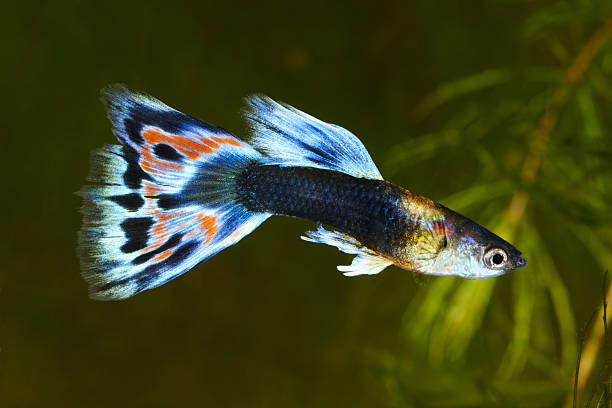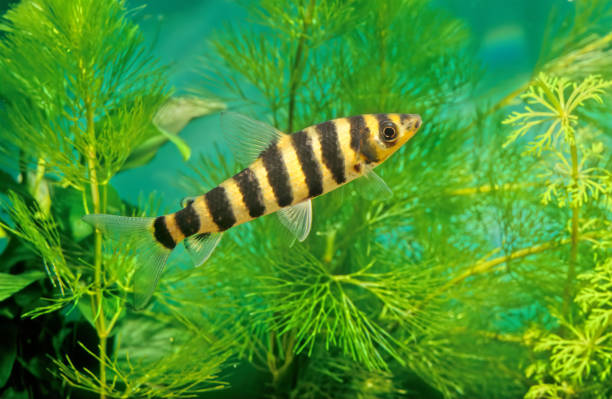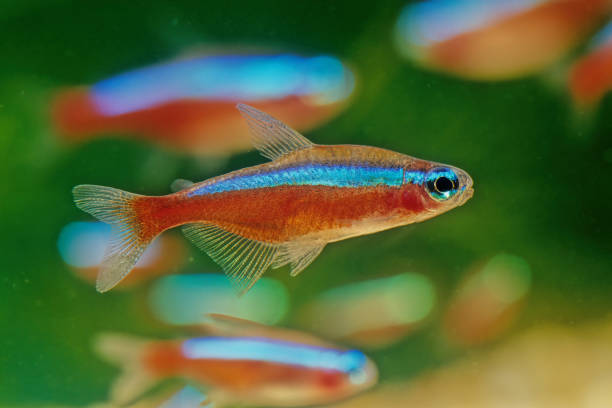Types of Colorful Aquarium Fish
While aquariums are often perceived as dull, boring or colorless, there are many vibrantly colored freshwater fish. Adding the right plants, food and water conditions will bring out the best in these eye-catching creatures.
Guppies are one of the most popular colorful aquarium fish. They are active, social and pass on their beautiful colors to offspring. They require a tank of at least 10 gallons with close population control.
Guppy
Guppies add a lot of color to a freshwater aquarium. Their scales can be bright blue, red, yellow, green, black or orange. Their tail fins can be fan shaped, lyre shaped or even snakeskin patterned.
The males and females are distinct in colour and the males have longer caudal and dorsal fins. They are hardy, energetic and breed prolifically in a fish tank.

The guppy is an excellent choice for the beginner. It requires warm aquarium water and a varied diet. It also can be acclimated to brackish water. The guppy is sometimes referred to as the millions fish because it reproduces at an incredible rate. Its other common nickname is Dumbo ear guppy for its long pectoral fins that resemble the Disney character’s ears.
Cobra Guppies
Guppies are hardy, vibrantly colored fish that are favored by freshwater enthusiasts. They’re peaceful and active, making them good tank mates for other non-aggressive species of freshwater fish. They’re also known to graze on algae, making them a great choice for beginners.
Fancy guppies come in many colors and patterns, from tuxedo pattern (half black) to leopard pattern with large spots on the fins and tail. You can create a stunning display in your aquarium by creating a shoal of varying colors and forms. Just be sure to avoid mixing guppies with fish that are known fin nippers, as the tails may become a tempting snack. Interestingly, female guppies often choose mates that have unique color patterns, even after they’ve been bred a number of times.
Leopard Tail Guppies
The Leopard Tail Guppy is a vibrant freshwater aquarium fish that adds an exotic touch to any tank. Its sleek and slender body is beautifully complemented by its distinctive leopard-like tail.

This guppy is also known as the fan-tail guppie, and it comes in a variety of colors and patterns. Its color palette can range from bright purple to black, with the head and fins being a lighter shade of green or white.
These guppies are very easy to care for and make great beginner fish. They live well in planted tanks with low to moderate water flow and can co-exist with a wide range of other fish and aquatic snails.
Mosaic Guppies
Guppies showcase a mosaic-like pattern of different colors on their body and fins. They come in a range of color variations, including the Snakeskin pattern with its intricate net-like design and the Tuxedo pattern with contrasting darker colors on the front and lighter fins.
Guppies exhibit fascinating courtship rituals, swimming in front of females and spreading their brightly colored fins to woo them. Males are particularly persistent in pursuit of female guppies, and may even attempt to mate with them multiple times a day.
Guppies are known as livebearers, meaning that they reproduce by internal fertilization and give birth to fully-formed offspring. They thrive in tropical settings and require a tank with plenty of hiding places. They also enjoy schooling with other peaceful tank mates.
Cardinal Tetra
Cardinal tetras (Paracheirodon axelrodi) are a classic favorite for a pop of color in an aquarium. These fish are shoaling, so they do best in groups and require a moderately large tank.
In the wild, cardinal tetras exhibit an iridescent blue line that bisects their body and is complemented by a vivid red stripe below it. Their tails are transparent and the rest of their fins are also white.

These fish are omnivorous and will thrive in captivity on a diet of flake food, pellets, frozen bloodworms and tubifex. They do well in heavily planted tanks that replicate their natural habitat. Cardinal tetras are a good choice for community tanks with bottom dwellers like corydoras catfish, kuhli loaches and otocinclus catfish, as well as with discus, angelfish and German blue rams.
Celestial Pearl Danio
Danios are a popular fish that have made a big impression on aquarium enthusiasts since their discovery. Their playful nature and splendid appearance make them an ideal tank companion. They are hardy and can withstand temperature changes and different PH levels. They are also easy to care for as long as the tank is properly conditioned.
The Celestial Pearl Danio, also known as the galaxy rasbora, is a small fish with vivid colors. Its base coloration is midnight blue and it is covered with bright yellow/white spots that give it its unique look. Its fins are red or orange and have black stripes.
Male Galaxy Rasboras are thin and showcase more vivid colors, while females are duller with a rounded belly. They eat both live foods and pellets.
Neon Tetra
Neon tetras are very social fish and enjoy living in shoals. They are also very easy to breed in captivity.
They thrive in a tank environment that mimics their natural habitat. This means creating a dim, dark area with lots of dense vegetation and driftwood to provide hiding places. The aquarium should also have a dark substrate.
Unlike most fish, neon tetras do not appreciate bright light. This is because their eyesight diminishes in bright environments. These fish also tend to become easily ill. Some common illnesses include ich, fin rot and haemorrhagic septicaemia. These fish also suffer from a lack of exercise.
Bolivian Ram
Bolivian Rams are a very popular aquarium fish among aquarists due to their beautiful coloring and ease of care. They are a hardy, peaceful cichlid that thrives in a community tank with a variety of tank mates as long as they are a similar size.
Males are more vibrantly colored and display elongated dorsal fins that can be extended during breeding. Females have rounder, shorter fins.
They tend to become territorial during breeding, but once paired they bond for life and are very docile. They do well in small groups, but are equally happy alone. In the wild, they hunt algae, plants and other organic matter floating along riverbeds.

